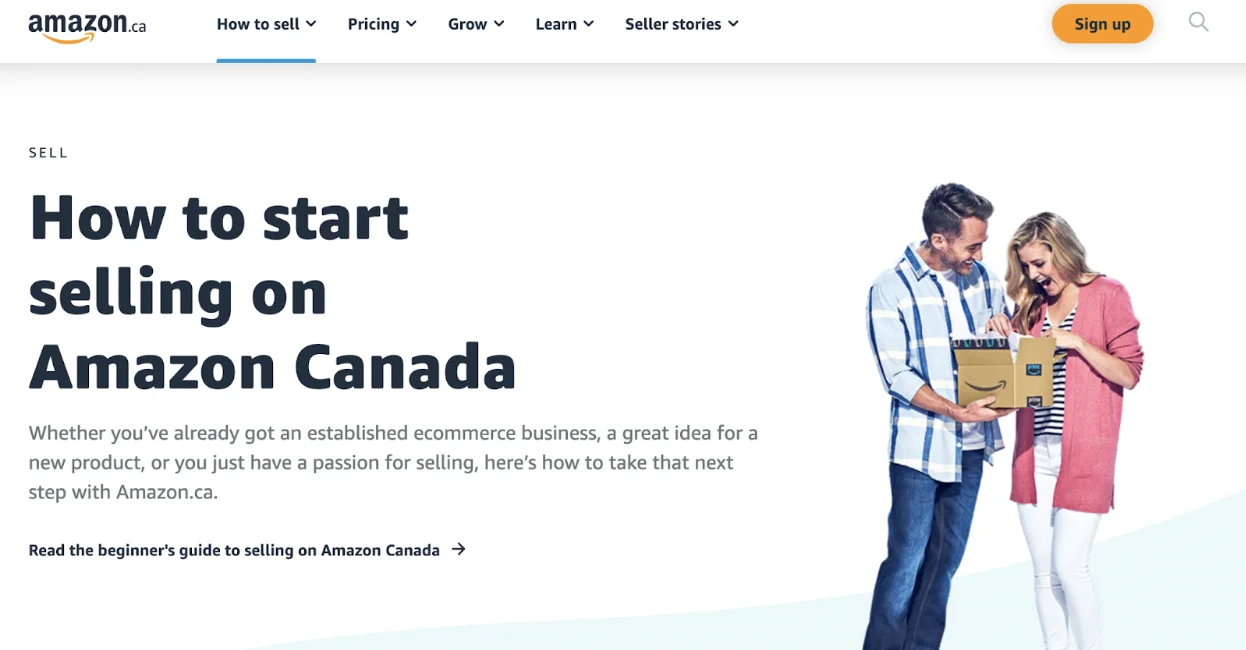Table of Contents
 Amazon Canada gets 16 million unique visitors per month from the state alone.
Amazon Canada gets 16 million unique visitors per month from the state alone.
Last year, 30,000 Canada-based third-party merchants grossed more than $ 1 billion on AMZ Canada, showing a 40% year-over-year increase.
Thus, the time is now to begin selling your products on Amazon.ca.
This article will tell you everything you should know to become a successful merchant on this great platform.
We’ll cover how to sell on Amazon Canada, explore the latest trends and statistics around Canadian online customers, and even dive into the little details around commissions, taxes, and more.
Why Should You Sell on AMZ Canada?

Canada accounts for about 10% of the population of America, so simply by the math, you may expect about a 10% order boost for any item by offering your goods in Canada. Many items punch above the weight in the country (so they generate more sales than anticipated for a population of Canada’s size) as the competition is much less intense. An item that you may have no option of ranking for on Amazon.com, you may potentially simply rank for on Amazon.ca.
As Canadians favor the marketplace more, the competition is likely to grow. Just for this reason alone, we think when you have dreams of one day growing your business in Canada, now is the high time you did it to solidify your rankings and reviews in the country and get a first-mover benefit.
One of the other perks of selling on Amazon Canada is that you may leverage multi-channel fulfillment to deliver orders from your store to Canadians right from Canada (you can’t use MCF for worldwide orders). It avoids long transit times and duties, so it’s a huge advantage for Canadians.
The state’s selling tax system is also much easier than many other countries (specifically Europe), and AMZ will manage federal sales tax for you usually (check out more information below).
How to Set up a Seller Account in Canada?

This part will cover all the tips you should know if you want to become an Amazon seller in Canada.
So to the Start Selling Online webpage of Amazon.ca or the Amazon Canada app.
Similar to other marketplaces, AMZ Canada has two plans for sellers: Professional and Individual.
Individual:
It’s good for novice sellers who do not plan to sell much merchandise per month. Thus, it is a great solution for those who begin with eCommerce without paying a monthly commission— just a flat cost of $1.49 CDN per order.
Pick this option if you:
- are going to sell fewer than twenty products per month (after 20 units, the total per-sale expenses will be more than the monthly cost for the Professional seller plan).
- do not need the advanced selling features or add-on tools included with the Professional subscription.
- are still hesitating about what items to sell.
Professional:
The professional seller subscription is reasonable if your brand sells more than 20 products per month, as you will pay a fixed monthly commission of $29.99 CDN.
Pick this option if you:
- are going to sell more than 20 units per month.
- wish to access additional selling features and promotion capabilities.
- want to use selling programs such as Launchpad, AMZ Business, or Handmade.
Now that you know the difference between Professional or Individual plans let’s discuss the registration process.
To finish your seller registration, you’ll need the following information:
- Bank account info, including your profile and routing numbers
- Active credit card
- Phone number
- Tax info
- Government-issued national ID
On your Start Selling Online webpage, choose “Sign up.” Then, register a new AMZ profile with your login and password.
Then fill in your business location and other information. You can offer your products on the Canadian platform when you’re located outside of the state.
For business kind, you can pick a few options:
- Publicly-listed company
- State-owned company
- Privately-listed company
- Charity
- No, I’m an individual
If you do not have a registered company, pick“No, I’m an individual.” Or choose the option that best fits your business and click on the “Agree and continue” button.
Your next steps mean entering your info, including:
- Your company’s physical address
- Phone number
- Bank account and billing information
- DOB
- Selling plan and store name
As soon as you fill in all of this necessary information, AMZ will have to verify your profile before the platforms approve your profile to sell. Then, when you’re approved, you may start listing products for sale!
How to Optimize Your Product Listings for Customers?
Let’s assume you have now done your product research, you know the target audience, and you have decided what you are going to sell.
What is next?
To begin with, you need to concentrate on client experience. You will want to ensure your product pages are accurate, easy to understand, and concise.
Below are some quick tricks to help your buyers easily find (and purchase) your items:
- Include pictures of the item that are at least 500 x 500 pixels (1000 x 1000 is even better).
- Write no more than 50 symbols for the product titles and capitalize only the first letter of each word (not all caps)
- Optimize the product descriptions for Amazon search engines using keywords and phrases to make them simpler to find.
- If you are selling an item your competitors are offering, look for strategies to make your pages the ones they go for.
Remember: It’s just the tip of the huge iceberg. Product research must be an ongoing thing, as well as researching the AMZ marketplace itself and any changes and updates. Moreover, do not forget to leverage the power of social proof. The more reviews visitors see for your items, the more likely they are to buy them.
Luckily, SageMailer can help expand your reach and communicate with buyers on multiple AMZ marketplaces within a single platform.
Selling on Amazon Canada from the US and Other Marketplaces
Amazon has many websites or marketplaces divided into four distinct regions: Americas, Asia-Pacific, Europe, and the Middle East &North Africa. Selling on one platform simplifies advertising and selling products in neighboring AMZ marketplaces within the same area.
When sellers sign up for a Seller Central profile in the Americas, they automatically get access to a North America Unified profile, allowing them to switch between Amazon.com, Amazon.mx, and Amazon.ca with ease and without additional charges.
Besides, you do not need to open up a CA bank profile or enlist a new business—ANZ will convert your profits into USD and immediately transfer them to the local bank account.
Amazon Global Selling
If you have an AMZ store from outside the Americas and want to sell in Canada, you will need to engage in the platform’s Global Selling.
It enables companies to sell and market their goods in another AMZ region. This program also includes the Build International Listings (BIL) feature that helps make offers on new platforms to deliver a more localized customer experience.
Since Amazon Canada is in the English language, you will not need much translation if, for example, you are operating in the UK and wish to work with Canadian shoppers.
Global expansion might become the next step if you have found significant success in your country. However, before you try Amazon Canada (or any other AMZ marketplace), consider the points below:
- Is it worth offering your products in Canada? Can you anticipate returns that justify the effort and time it’s necessary to expand into a new AMZ market?
- Are your products restricted from selling in Canada?
- Do you need to be a resident of one of these states?
- Do you have a worldwide chargeable credit card and a working phone number?
Amazon Canada Seller Fees
One of the essential things you should do before expanding to Canada is to calculate how much you will need to spend. Selling via FBM or FBA means you will be liable for some selling fees, which depend on whether your stock goes through the platform or directly from your supplier.
You may need to pay transportation costs due to import and customs fees; however, selling taxes aren’t very complicated in Canada. For more info about Canadian tariffs, check out this link.
Referral commissions
If you want to sell your products on AMZ, the referral commission is a fee you must pay Amazon CA for selling on the platform. It’s typically up to 15% of the item’s selling price.
FBA commissions
If you opt for using the FBA fulfillment method, the marketplace charges additional costs for managing your storage, packaging, shipping, and client services. The number of expenses that FBA merchants pay is defined by the dimensions of the goods sold.
FBA storage charges
Apart from the commissions associated with fulfilling an order, merchants are also liable for storage payments if they use the platform’s warehouse space. Amazon charges two types of long-term storage fees: yearly or monthly.
Long-term storage commissions
AMZ long-term storage charges are computed on the 15th of every month, and products that have been held there for over 365 days are charged $150 per cubic meter.
Monthly storage commissions
AMZ monthly storage commissions are charged within one or two weeks days for any month. For instance, check your February payments report to see your stock storage fees for January.
Canadian Tax System and Regulations
Suppose you’re considering running your business in Canada. In that case, you’re responsible for destination duties, customs clearance commissions, and taxes before your products can be sold to residents or kept at an AMZ fulfillment center. You or the designated agent should act as the Importer of Record and be stated as such on all customs declarations.
Canada has a complex and unique tax structure that comprises provincial and national sales taxes, which might be divided into four classes:
- Provincial Sales Taxes – 6-10% across the state. Particular provinces or territories add a charge and demand companies to register and remit it separately.
- Quebec Sales Taxes – 9.975%. This charge is calculated depending on the selling price, excluding the main tax on goods and services.
- Goods and Services Taxes – 5% across the states. It’s a national selling tax.
- Harmonized Sales Taxes – Up to 15%. The combination of PST and GST allows companies to remit the full amount to CA Revenue Agency.
Final Thoughts
Amazon CA is another chance for merchants to leap forward in other marketplaces, and it is an excellent place to dip your toes into a worldwide Amazon selling approach. However, you need to check a few boxes first. We hope that now you know how to sell products on Amazon Canada.
SageMailer is a seller tool that can help you get product reviews and grow sales in any Amazon marketplace. It’s easy to use, and the availability of free how-to resources and guides will get you up to speed, even when you have no clue how to gather feedback on the platform!
Don’t worry about wasting your money on a subscription—check out a 30-day free trial and see for yourself!

